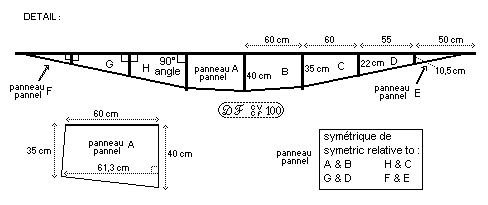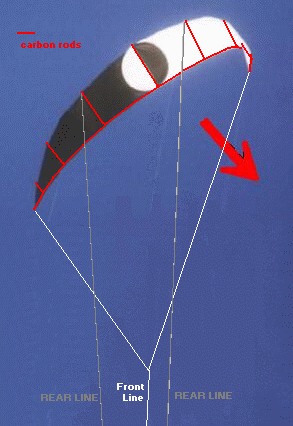Wazo :
FAQ
- "I noticed that on panels
A & B, three of the four angles are not 90 degrees.
Are the other
panels more rectangular ?"
- Yes. The 2 darts (1,3cm)
of the sail are on the right and left 35cm batten. It's sufficient to obtain a
conical sail (the front edge is shorter than the rear edge) therefore the
"arch" may move forward. Otherwise, the kite doesn't take off. All other
sections have two 90 degree angles (both of which are on the leading
edge.)

- Les panneaux A et B ont 3
angles non rectangulaires sur 4 . Ce sont les seuls. La toile est légèrement
pincée au niveau des lattes droite et gauche de 35 cm : un ajout de 1,3 cm
côté bord de fuite (arrière). Ce la est suffisant pour que la toile soit
conique (bord d'attaque plus court que le bord de fuite), ce qui permet le vol
de l'arche. Sinon, le cerf-volant ne peut pas décoller ni avancer.
- "Has only panel A and B ,
rearside, on its outside 61.3 cm (1.3 cm more) ?"
- Yes. The 2 darts (1,3cm)
of the sail are on the right and left 35cm batten. It's sufficient to obtain a
conical sail. Therefore the "arch" may move forward. Otherwise, the kite
doesn't take off.
- "Have you flown a
REVOLUTION 4 line kite? if so how does the WAZO compair ?"
- It's very different, and
all my quadline and threeline kite creations have a different flight (and
steering) relative to the Rev, and different themselves. With the exception of
the wing beating, the Wazo's flight is between the quadline flight and the
dual line flight. It stops and corkscrews.The lateral slides won't work as
they do with several "4 liners" unlike the Revolution, reverse is slow. Its
wind scale is somewhat wide. When its speed increases, the wings beat
naturally. You can control this wing beating. You can also steer the Wazo
"statically" by means of only one hand in such a way that it beats its wing at
the top of the wind window.
- Le vol du Wazo est très
différent du Révolution : à mi-chemin entre un 2-lignes et un 4-lignes. Il
stoppe, vrille sur place, recule doucement, mais il ne glisse pas
latéraelement comme le Révo. Par contre, il bat des ailes naturellement dès
que le vent forcit.
 "There is two front bridles at (x) on each side of the kite (9 meter
length). And a bridle on the rear left and one on right side each 10,20 meter,
but there is no bridle at the front left and right side (each 10,20 meter )
?"
"There is two front bridles at (x) on each side of the kite (9 meter
length). And a bridle on the rear left and one on right side each 10,20 meter,
but there is no bridle at the front left and right side (each 10,20 meter )
?"
- No, it is an arch : the
two "rear side" bridles are used to steer the arch.
Il n'y a pas de bride
sur le bord d'attaque, uniquement les 2 brides (x) d'extrémités comme un Sled,
et 2 brides gauche-droite sur le bord de fuite pour piloter l'appareil.
- "I went to fly this novel
design and could not get off the ground."
- While you are not used to
steering this kite, try when the wind is medium to strong. The first time, ask
an assistant his help to raise the kite from the ground. Otherwise, pull in
quickly on the rear lines with one hand to take off . The "taking off" of Arch
kites is not easy, except with strong wind.
Verify the length of your
bridles + lines as follows : fix the handles; go to the kite; stretch the kite
into a half circle; now, all the bridles and lines must be stretched; after,
you can shorten a tiny bit (10 to 20 cm) the front line.
DON'T put elastic
tension bands at the tips (x) . Otherwise the sail is not conical.
Made in
spi or nylon the leading edge carbon is loose in its sleeve, and relative to
the battens. And the 2 bridles (x) are fixed to the end of the sails. (same
argument).
- Problème de décollage
:
Lors des premiers vols, commencez dans un vent médium (force 3-4),
faites-vous aider par un assistant pour décoller l'appareil.
Sinon pour
décoller, tirez vivement avec une main sur la ligne avant.
- Vérifiez votre bridage
ainsi : attachez vos poignées, puis allez au cerf-volant et tirez sur le jonc
de bord d'attaque pour obtenir un demi-cercle, toutes vos lignes et brides
doivent être tendues maintenant, alors il ne reste plus qu'à raccourcir la
ligne avant de 10 à 20 cm.
NE METTEZ PAS d'élastic de tension de votre
toile aux extrémités (x), sinon la toile tendue n'est plus conique.
- "Maybe a stupid question
but what is the top and what's the bottom ? From the pictures I understood
that the bottom is were you have 2 different flying lines and the top has 2
that come together. Am I right?"
- The top is the side which
first receives the wind. The photo is nice but ambigous. Look at the image on
the right to understand in which direction the Wazo goes.
- La photo est ambigue
quant à l'avant et l'arrière du Wazo. aussi, la photo à gauche figure les
vergues et le sens d'avancée du Wazo.
- "I want to build a wazo
with a doube size."
- If you change the size of
the Wazo, you must find a front edge carbon rod which have the same rigidity
relative to its lenght. The wing beating depends on this relation.
Si vous
voulez changer la taille du Wazo, il vous faudra trouver un jonc carbone de
bord d'attaque dont la rigidité sera équivalente relativement à la nouvelle
taille du Wazo. Le battement des ailes dépend de ce rapport.
-
-
Please, tell me your
difficulties so that I improve the explanations : Didier.Ferment@u-picardie.fr
Dites-moi
vos difficultés de construction de ce plan afin que j'améliore les
explications.
Good Flight
Bon
vol
Didier
[Page précédente - Back]
 "There is two front bridles at (x) on each side of the kite (9 meter
length). And a bridle on the rear left and one on right side each 10,20 meter,
but there is no bridle at the front left and right side (each 10,20 meter )
?"
"There is two front bridles at (x) on each side of the kite (9 meter
length). And a bridle on the rear left and one on right side each 10,20 meter,
but there is no bridle at the front left and right side (each 10,20 meter )
?"